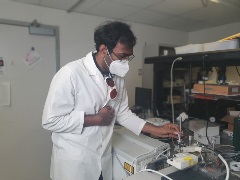A dual-wavelength laser system can help prevent bleeding and keep the surgeon’s view clear during surgery.
Wausau, WI (September 21, 2022) – In highly vascular tissues or blood-filled regions like the brain, any inadvertent damage to blood vessels can obscure the surgeon’s field-of-view and complicate surgery. Lasers provide an opportunity to choose specific colors of light to perform surgery while also keeping the surgeon’s view clear with a blood-free environment and a clean surgical field. By using the two-color laser approach presented in this study, brain surgery can be safer and more precise.
The preclinical report, led by Nitesh Katta, PhD, is titled, Er:YAG laser brain surgery with vascular specific coagulation.” The report, published in Lasers in Surgery and Medicine (LSM), the official journal of the American Society for Laser Medicine and Surgery, Inc. (ASLMS), was selected as the September 2022 Editor’s Choice.
 “The study was conducted to optimize use of lasers in neurosurgery. Er:YAG wavelength (2.94um) provides the most energy efficient methodology to cut soft tissue, however, bleeding is a challenge in surgery,” said Katta. “To prevent bleeding, a vascular specific wavelength was used (1070nm) in combination with the Er:YAG laser to provide bloodless resection while keeping the lateral thermal spread to a minimum.”
“The study was conducted to optimize use of lasers in neurosurgery. Er:YAG wavelength (2.94um) provides the most energy efficient methodology to cut soft tissue, however, bleeding is a challenge in surgery,” said Katta. “To prevent bleeding, a vascular specific wavelength was used (1070nm) in combination with the Er:YAG laser to provide bloodless resection while keeping the lateral thermal spread to a minimum.”
To demonstrate this two-color laser approach, nude mice underwent in vivo stereotactic laser surgery with the Yb/Er:YAG dual wavelength vascular specific neurosurgery under image guidance using an optical coherence tomography (OCT) system. OCT and OCT-derived angiography (OCTA) were used to record cortical images to confirm blood vessel coagulation and guide subsequent Er:YAG resection.
Experimental results suggest that the developed dual-wavelength laser system can effectively resect neural tissues with high localization, minimal lateral thermal spread at the micrometer level while maintaining a bloodless surgical field.
Nitesh Katta received his PhD in 2019 from the University of Texas at Austin and is currently a postdoctoral fellow at the Beckman Laser Institute (BLI). At BLI, Nitesh continues to work on conducting basic science and translational research in novel laser energy-based devices and image-guided therapy applications in dermatology and cardiology, among other light-tissue interactions.
Editor’s Choice is an exclusive article published in LSM, the official journal of the ASLMS. View the complete manuscript.
The American Society for Laser Medicine and Surgery, Inc. (ASLMS) is the largest multidisciplinary professional organization dedicated to the development and application of lasers and related technology for health care applications. ASLMS promotes excellence in patient care by advancing biomedical application of lasers and other related technologies worldwide. ASLMS membership includes physicians, surgeons, nurses, and allied health professionals representing multiple specialties, physicists involved in product development, biomedical engineers, biologists, industry representatives and manufacturers. For more information, visit aslms.org.